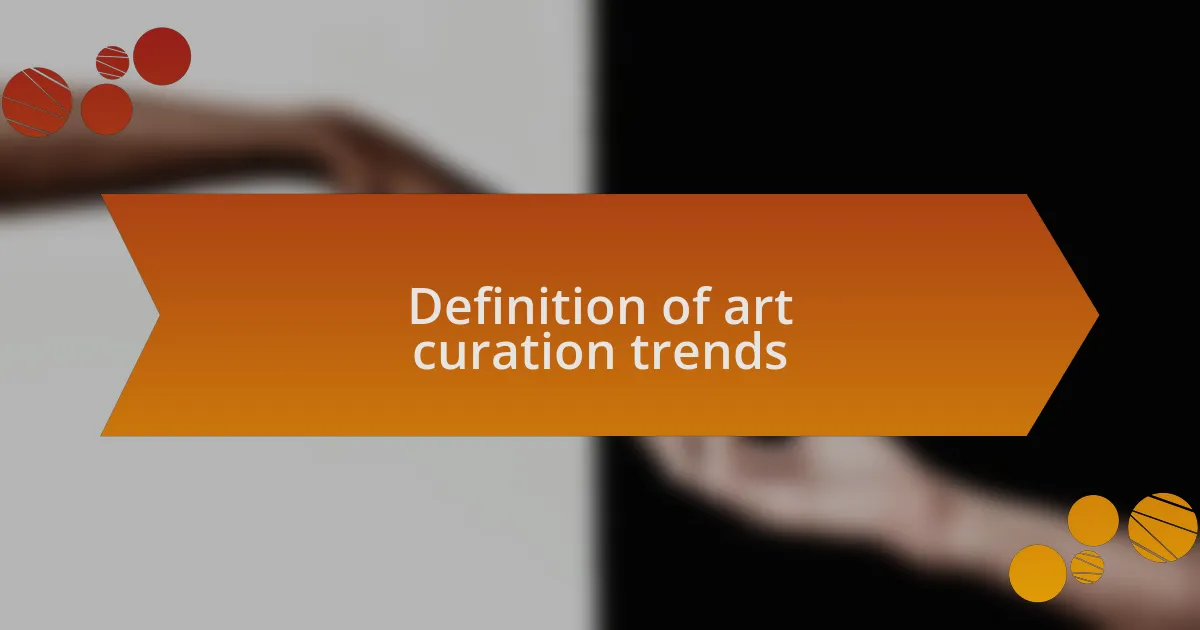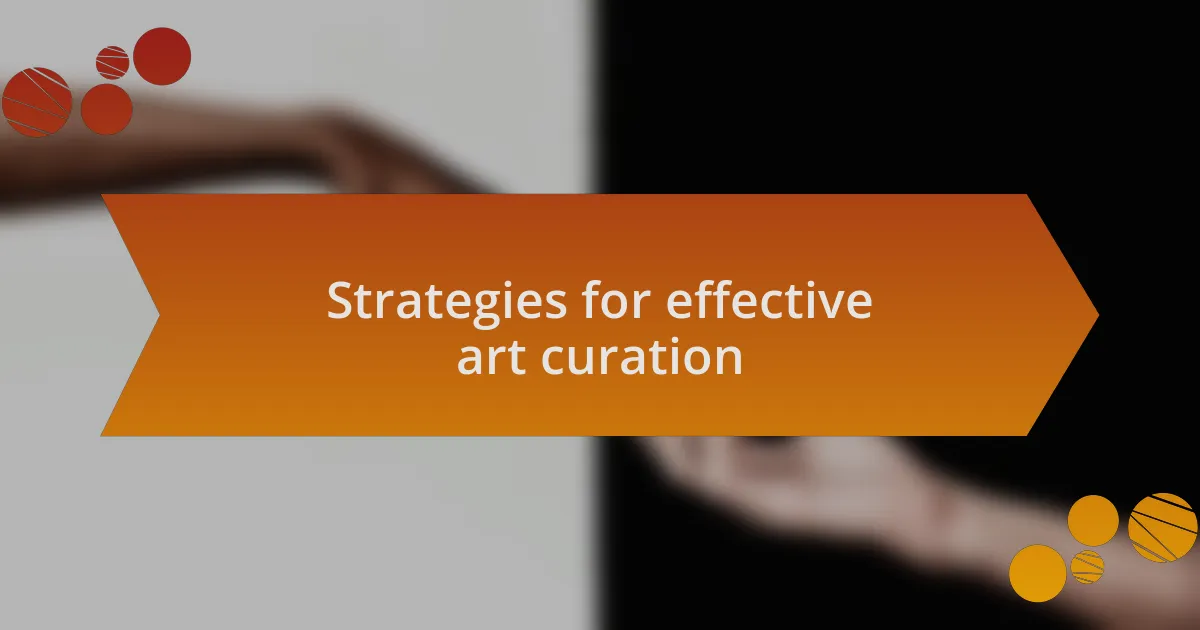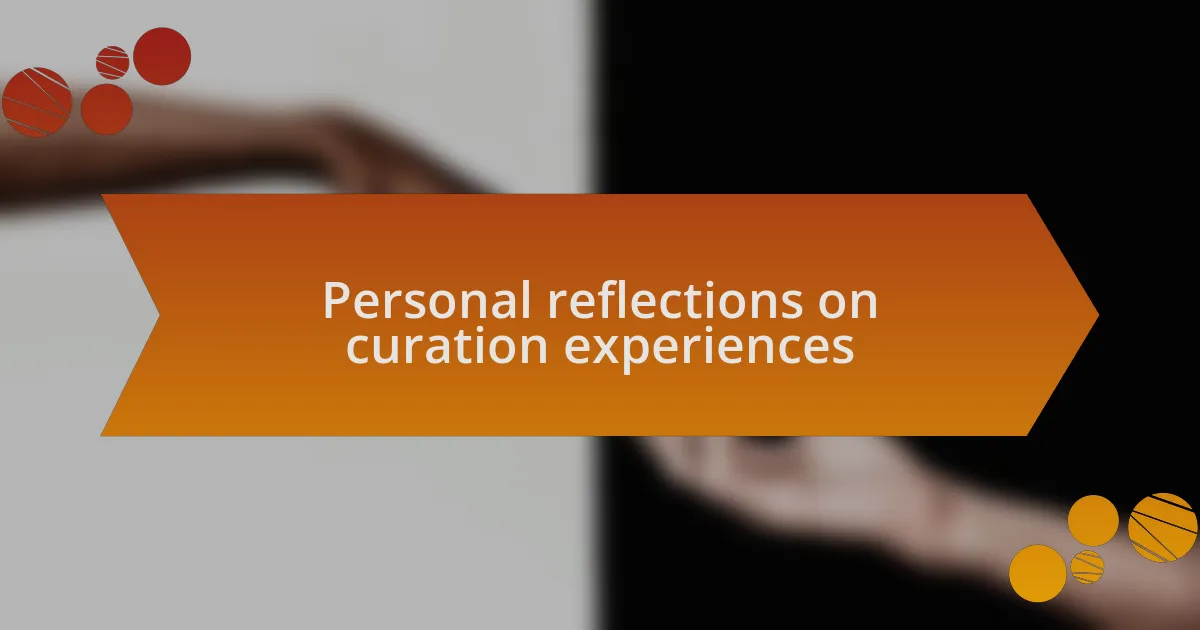Key takeaways:
- Art curation trends focus on inclusivity and diversity, showcasing underrepresented artists and narratives.
- Experiential art shows and sustainability in exhibition design are prominent current trends that enhance audience engagement.
- Effective curation strategies include selecting themes relevant to contemporary issues and leveraging technology to enrich visitor interaction.
- Personal experiences in curation highlight the transformative impact of art and the importance of creating connections through exhibitions.

Definition of art curation trends
Art curation trends refer to the evolving practices and methodologies that curators employ to present and interpret artworks in galleries. These trends often reflect broader societal changes, as curators adapt to shifts in culture, technology, and audience engagement. It’s fascinating to consider how these changing paradigms influence not just the art we see, but also how we experience it.
In my experience, a significant trend has been the increasing focus on inclusivity and diversity in exhibitions. Many curators now prioritize showcasing underrepresented artists and narratives, which challenges traditional art hierarchies. This shift opens up an exciting dialogue—what happens when new voices gain visibility in spaces once dominated by a few established figures?
Another critical aspect that often gets overlooked is the integration of technology into curation. As galleries begin to embrace digital platforms and augmented reality, I find myself asking: how does this reshape our perception of art? It’s not just about displaying images anymore; it’s about creating immersive experiences that enhance our understanding. Engaging with these trends allows us to rethink the relationship between art, audience, and space in profound ways.

Current trends in art exhibition
As I delve into current trends in art exhibitions, one noticeable shift is the rise of experiential art shows. These exhibitions invite viewers to fully engage with the work, often immersing them in multi-sensory environments. I remember attending an interactive installation that blurred the lines between the artist’s vision and the audience’s experiences—it made me reflect on how art can provoke not just thought, but genuine emotion.
Another intriguing trend is the push toward sustainability in exhibition design. Curators are increasingly aware of their environmental impact and are opting for eco-friendly materials and practices. I find it inspiring when galleries use recycled elements or support local artists by sourcing materials sustainably. This not only reflects a commitment to the planet but also resonates with audiences who value conscious consumption—it’s a win-win situation that enriches the entire art dialogue.
Finally, collaboration is more prominent than ever in art curation. I have seen exhibitions where artists, curators, and even community members co-create the narrative. This approach democratizes the curation process and can lead to enriching outcomes. Wouldn’t it be fascinating if every exhibition told a story shaped by diverse voices? Embracing such collaborative efforts opens the door to new perspectives and creates a more dynamic art landscape.

Strategies for effective art curation
One effective strategy for art curation is the careful selection of themes that resonate with contemporary issues. I once curated a small exhibition focused on mental health, which not only highlighted powerful works but also sparked meaningful conversations among attendees. When curators choose themes that reflect societal concerns, it deepens the audience’s connection to the art, making the experience more memorable and impactful.
Utilizing technology can also elevate the curation process significantly. In my experience, incorporating augmented reality features in an exhibition can transform the way visitors interact with art. For instance, at one show, visitors could use their smartphones to unlock additional content, enhancing their understanding while creating a sense of discovery. Isn’t it exciting how technology can enrich the storytelling aspect of an exhibition?
Moreover, fostering community engagement plays a pivotal role in effective curation. I remember collaborating with local schools for an art show, where students contributed their pieces alongside established artists. This intermingling of voices not only created a vibrant atmosphere but encouraged local appreciation of the arts. How often do we witness communities coming together to celebrate creativity? It’s strategies like these that can truly redefine the art narrative and invite diverse audiences to participate.

Personal reflections on curation experiences
Curating art exhibitions has always been a deeply personal journey for me. I remember one occasion when I had the opportunity to curate a show centered around the theme of identity. It was not merely about showcasing artworks; it felt like a reflection of my own experiences and those of the artists involved. This connection made every piece leap from the wall, resonating with both me and the audience in a way that felt almost transformative.
Another experience that stands out was when I curated a retrospective of a local artist whose work I admired for years. My heart raced as I pieced together works that spanned decades of their career. Each selection felt like uncovering a layer of their soul, and sharing that with the public felt like a privilege. Do you ever wonder how much deeper art can affect our understanding of the creator’s journey? It was this curiosity that drove me to create an immersive narrative that guided visitors through the artist’s evolution.
I’ve found that the magic of curation lies in those unexpected moments of connection. There was a time when a piece I chose, which I thought was underappreciated, ignited a passionate discussion among visitors about personal storytelling in art. Witnessing such engagement reminded me of how art has the power to forge connections between strangers. Isn’t it fascinating how something as simple as a painting can spark dialogues that linger long after the event has ended? These experiences continually shape my perspective on curation and enrich my passion for bringing art to life.